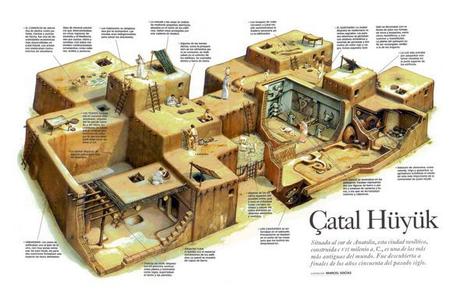Strange things are afoot at Catalhoyuk (7400-5600 BCE), one of the earliest and most important Neolithic (i.e., sedentary and agricultural) sites known to archaeology. As I noted in Bones, Burials and Ancestors, mortuary practices at Catalhoyuk were unusual and often involved secondary burial in the floors of homes.

The assumption has always been that these were grandpa’s and grandma’s bones. Many archaeologists, including Ian Hodder, have suggested this signals a change in community structure: ancestral lineages were linked to resource ownership and social stratification.
This is in stark contrast to nomadic hunter-gatherers who place little emphasis on ancestors, presumably because resources are communally shared. There is no need to link ancestral lineages to property or power.
A recent study, however, challenges these assumptions. Marin Pilloud and Clark Spencer Larsen studied tooth morphology to test the hypothesis that the multiple burials within each home were biological kin indicative of ancestral lineages. Their findings, however, indicated otherwise:
Results indicate that inclusion for interment within a house was only minimally related to biological affinity. Moreover, the site does not appear to be organized into larger, biologically related neighborhoods of houses.
These findings suggest that Çatalhöyük may not have been a kin-based society, largely because membership within a house cemetery was not solely defined on the basis of biological affinity, such as in a family group.
Rather, it appears that social structure was centered on the house as the unifying social principle. The choice for interment location may have transcended biological lines thereby creating an alternate and more fluid definition of “kin.”
While this is surprising it is not altogether unexpected. Hunter-gatherers had long been using fictive kinship to enlarge their relations and increase group size. There is significant ethnohistoric evidence of this among the Plains Indians. Most foraging bands were composed not of close kin, but of independent households that were attracted to particular leaders or chiefs.
To take but one well known example, suppose that Crazy Horse’s large band (about 900 people) of Lakota had been buried together by virtue of some catastrophic geological event. Although a study of tooth morphology would reveal a good deal of biological kinship, many would not be so related. This does not mean Crazy Horse band members did not consider themselves kin (because they mostly did) but it would show that kinship was not a simple matter of biology. Viewed from this perspective, we should not be overly surprised by these findings from Catalhoyuk.
It is always good to be reminded that our assumptions may be wrong and that we cannot simply project modern ideas about ancestry into the deep past.
Reference:
Pilloud, Marin A., & Larsen, Clark Spencer (2011). “Official” and “practical” kin: Inferring social and community structure from dental phenotype at Neolithic Çatalhöyük, Turkey. American Journal of Physical Anthropology (May 17) : 10.1002/ajpa.21520



